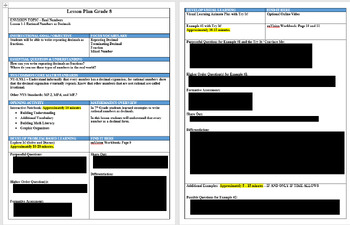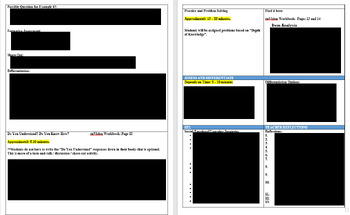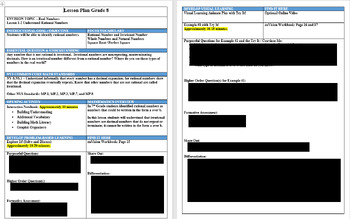8th Grade enVision MATH Topic 1 - Real Numbers - Lesson Plan BUNDLE
- Zip
Products in this Bundle (10)
showing 1-5 of 10 products
Also included in
- This BUNDLE includes 52 LESSON PLANS!This is for the ENTIRE 8th GRADE enVision CURRICULUM!All lesson plans are EXTREMELY DETAILED and directly connect to the enVision Math Curriculum for 8th grade. These are JUST THE LESSON PLAN DOCUMENTS, NOT the actual activities or assessment tools. The lessoPrice $467.53Original Price $519.48Save $51.95
Description
This bundle includes TEN LESSON PLANS. All lesson plans are EXTREMELY DETAILED and directly connects to the enVision Math Curriculum for 8th grade.
These are JUST THE LESSON PLAN DOCUMENTS, NOT the actual activities or assessment tools.
The lessons included in this bundle are for TOPIC 1 - Real Numbers. The lesson titles are as follows:
Lesson 1-1: Rational Numbers as Decimals
Lesson 1-2: Understand Irrational Numbers
Lesson 1-3: Compare and Order Real Numbers
Lesson 1-4: Evaluate Square Roots and Cube Roots
Lesson 1-5: Solve Equations Using Square Roots and Cube Roots
Lesson 1-6: Use Properties of Integer Exponents
Lesson 1-7: More Properties of Integer Exponents
Lesson 1-8: Use Powers of 10 to Estimate Quantities
Lesson 1-9: Understand Scientific Notation
Lesson 1-10: Operations with Numbers in Scientific Notation
Each lesson plan is 4 pages long and includes the following categories:
- enVision Topic
- Next Generation / Common Core Standards
- Instructional Goals
- Essential Question
- Vocabulary
- Supplementary Materials
- Develop Problem Based Learning - Solve & Discuss It
- Practice and Application Activities
- Scaffolds / Differentiation / Questioning
- Developing Visual Learning with Examples and Videos
- Practice and Application
-Item Skills Analysis
- Special Education Component
- English Language Learner Component
- SEL Component
- Review, Assessment, and Extension
- Teacher Lesson Reflection Questions
These are JUST THE LESSON PLAN DOCUMENTS, NOT the actual activities or assessment tools.
**PLEASE REMEMBER TO LEAVE A REVIEW :)
***TPT will give you "credits" for every review that you leave!!
****Thank you so much in advance!!






